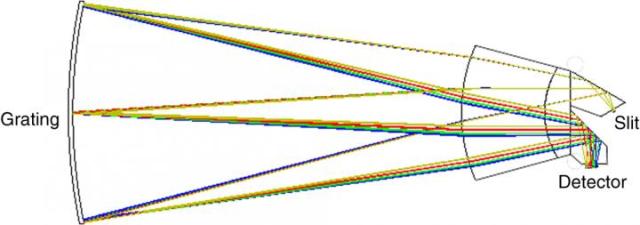Feb 2 2016
For more than 40 years, Landsat satellites have provided a wealth of data that has informed our understanding of Earth features, phenomena, and environments as diverse as coral reefs, urbanization, tropical deforestation, and glaciers.
 CAPTION:JPL researchers report in Optical Engineering on a new imaging spectrometer design to improve Landsat images. Above, Fig. 3: Spectrometer ray-trace in the spectral direction. The two reflecting prisms and planoconvex element are made of CaF2. The grating aperture as shown is 14 cm in diameter.CREDIT:Pantazis Mouroulis, JPL, et al.USAGE RESTRICTIONS:None
CAPTION:JPL researchers report in Optical Engineering on a new imaging spectrometer design to improve Landsat images. Above, Fig. 3: Spectrometer ray-trace in the spectral direction. The two reflecting prisms and planoconvex element are made of CaF2. The grating aperture as shown is 14 cm in diameter.CREDIT:Pantazis Mouroulis, JPL, et al.USAGE RESTRICTIONS:None
Now, scientists at the Jet Propulsion Lab (JPL) at the California Institute of Technology have developed a way to substantially improve images derived from Landsat systems.
Pantazis Mouroulis and colleagues at JPL describe in a new article published in Optical Engineering the design of a high-throughput and high-uniformity pushbroom imaging spectrometer and telescope system that is capable providing Landsat swath and resolution with better than 10 nm per pixel spectral resolution over the full visible to short-wave infrared band.
The Landsat 8 satellite carries a thermal infrared sensor and an operational land imager (OLI). The OLI replaced a thematic mapper found in the previous Landsat generations, which used a scan mirror to cover the required wide swath. OLI instead utilizes long detector arrays in a pushbroom fashion, the authors note in "Landsat swath imaging spectrometer design."
While the removal of the scan mirror is an advance in terms of signal to noise, reliability, and potential simplicity of design, the OLI design still suffers from registration concerns between bands owing to the nonsimultaneity of data collection.
An imaging spectrometer does not suffer that problem since it is capable of collecting all bands simultaneously.
Even more important is the enhanced science potential that the full spectroscopic capability brings, the authors note.
"However," they write, "it has been generally difficult to find optical spectrometer and system solutions that satisfy the swath, resolution, spectral range, and signal to noise ratio of the heritage systems. We present in this paper a pushbroom imaging spectrometer design that can achieve these objectives."
Journal associate editor Thomas Cooley, a senior scientist with the U.S. Air Force Research Lab, emphasized the significance of the report, noting that it demonstrates new capabilities in "what is technically possible with advances in a range of supporting technology domains."